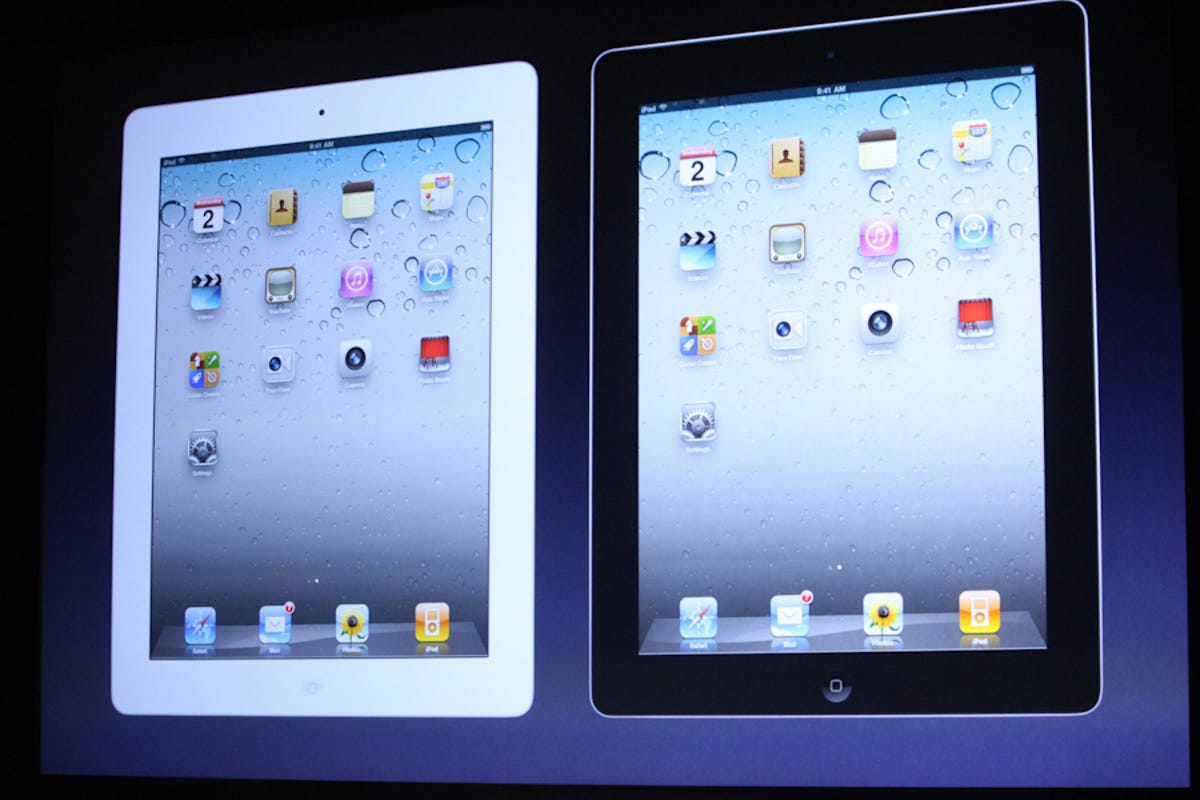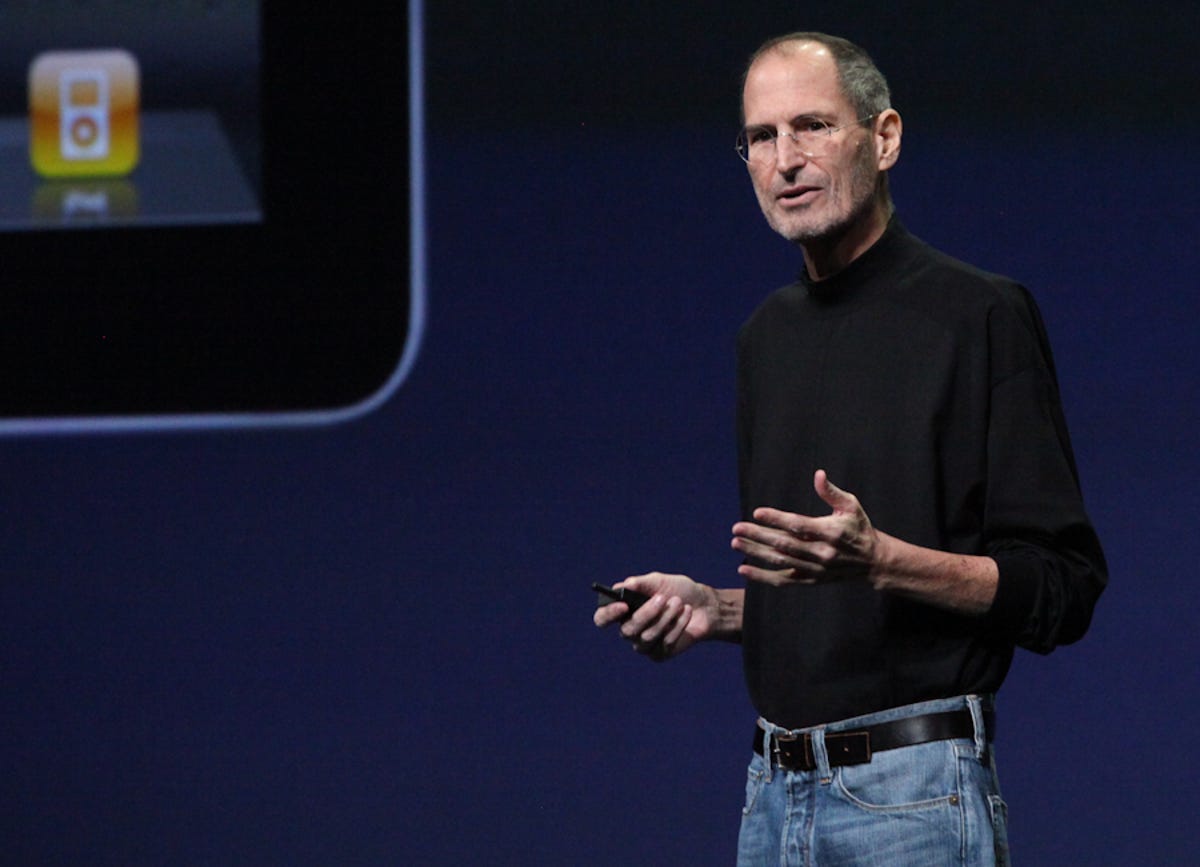
James Martin/CNET
The wait is over for eager Apple fans wanting the next-generation iPad. At an invite-only event in San Francisco today, the company took the wraps off the iPad 2.
Apple CEO Steve Jobs, who is taking a leave of absence from the company, returned to unveil the new product, which is expected to be a hot seller.
As anticipated, the new tablet has two cameras and is faster with dual-core processors. They just about double CPU performance and make the graphics speed 9 times faster, while using the same power as the processor from the first iPad. The iPad 2 is thinner than the older model. It went from 13.4mm in thickness on the old iPad to 8.8mm in thickness on the new one. And it works not only on AT&T’s 3G network, but also Verizon Wireless’ 3G network.
In terms of the technical specifications, the device is 9.5 inches high, 7.3 inches wide, and 0.34 inches deep. And it weighs just 1.33 pounds. It comes in three storage sizes for both the Wi-Fi and Wi-Fi +3G models: 16GB, 32GB, 64GB. And the rear camera is 720p and the front camera is “VGA-quality” suitable for video and still photography.
The new tablet will go on sale in the U.S. on March 11 and will start at $499. The original iPad, which went on sale last April, is now $399 for the 16GB Wi-Fi only version of the product. The 3G version of the 16GB iPad is $529. Apple will begin shipping the iPad 2 internationally to 26 countries starting March 25.


Now playing:
Watch this:
Jobs unveils iPad 2
5:38
The iPad 2 will also get some new features thanks to the latest release of the operating system, iOS 4.3. This upgrade brings a few new features like AirPlay support for apps that will include photo slideshows and porting audio from apps to other devices. Safari performance will be improved. This upgrade also adds the personal hot-spot feature that was introduced for Verizon iPhone owners. Other major tweaks include a software option to adjust whether the switch on the iPad is used to mute the volume, or lock the screen orientation, functionality Apple had changed after the iPad had been released.
The iOS 4.3 software version will be available on March 11, and it supports iPad, iPhone (GSM), and iPod Touch (third and fourth generation).
Apple also introduced some new accessories to the iPad 2. The first is an HDMI video-out option that will allow people to port video out of the device and mirror what happens on another screen. Jobs said this was a big request from teachers. It will cost $39 and works with all apps.
The other accessory is something called “Smart Covers.” This new case is a bendable flap that sticks onto the side of the device. It wakes up the iPad from sleep when you open it, and puts it to sleep when you close it. The cover uses magnets to grasp onto the unit, and align it. “You can add it in a second. You can remove it in a second,” Jobs said. The new case comes in five colors for the polyurethane version, and five as well for the leather. The polyurethane case is is $39, and the leather one is $69.
Also new to the iPad are some applications, including Apple’s iMovie and GarageBand applications, which are available for its Macs. The Apple iMovie app for the iPad will allow people to edit video right on their iPad and offers timeline scrubbing and clipping. The iPad uses gestures, so users can tap on parts of clips to add them to the timeline, as well as pinching pictures or icons to adjust things.
The iPad iMovie app also has an audio editor that lets you can adjust audio waveforms. Also included are 50 sound effects users can throw in their creations. Each video can have up to three audio tracks, in addition to a voice-over track you can record on the iPad’s microphone.
The Garage Band app, which helps teach people how to play musical instruments, has been adapted for the iPad. The application, which simulates different instruments, makes use of note dynamics, so that the iPad can tell how hard users are hitting the screen to affect the power of the note. This is handled via the accelerometer. Also included are “smart instruments,” which help novice musicians learn how to play. Similar to its desktop counterpart, the GarageBand iPad app can record whatever the user is doing and let him or her combine them together.
“Anyone can make music now, on something that’s this thick and weighs 1.3 pounds,” Jobs said. “It’s unbelievable. This is no toy. This is something you can use for real work.”
The iMovie and GarageBand iPad apps will each cost $4.99 and will be available in the App Store March 11.
The “Post-PC” era Apple created a new category of product with the iPad, doing what others before it had been unable to do. In short, it successfully convinced consumers that they needed something in between a smartphone and a laptop or desktop.
Apple’s Jobs noted this accomplishment. But he added that the iPad goes beyond being just another computing device. And while competitors focus on technical specs of their own products in this new category, Apple is still focused on providing an experience.
“It’s in Apple’s DNA that technology alone is not enough,” he said during the presentation. “It’s technology married with liberal arts, humanities that yields us the result that makes our heart sing. And nowhere is that more true than in these post-PC devices. And a lot of folks in this tablet market are rushing in and looking at this as the next PC.”
From the start, the iPad was a hit. Apple began selling the iPad in April 2010 and it ended up selling a whopping 15 million iPads by the end of 2010, accounting for $9.5 billion in revenue, according to Jobs. In the first fiscal quarter of 2011, the iPad has generated some $4.61 billion for Apple, which is about 17.2 percent of the company’s revenue. Not bad for a product that nobody really needed a year ago.
Brian White with Ticonderoga Securities wrote in a research note this week that he believes Apple could sell about 27.36 million iPads in fiscal 2011, generating $16.92 billion in revenue. He said that the iPad has turned into a crucial product for Apple and could represent one-third of Apple’s $36.8 billion in incremental revenue that is modeled for 2011.


James Martin/CNET
While the iPad is still hugely popular, the latest version of the device will face some competition. Unlike in 2010, this year there will not be just one or two competitors on the market, but instead there will be hundreds.
The most threatening competition could come from the top handset and computer manufacturers. Motorola is just now releasing its Xoom tablet, built on the latest version of the Google Android OS. Samsung has its Galaxy Tab line of products, which are also based on Android. Hewlett-Packard will introduce its WebOS-powered TouchPad this summer. Microsoft is also looking to get into the tablet market with a new OS that will bring Windows to the tablet form factor. And Research In Motion, the maker of the BlackBerry, is also set to introduce its tablet called the PlayBook.
But even with all this new competition, experts, such as CNET’s Donald Bell, believe that Apple still has a significant advantage over its competitors even if the new iPad 2 doesn’t offer too many more bells and whistles than the original version. He said in a recent interview with National Public Radio’s “All Things Considered” that Apple didn’t have to change things significantly on the iPad 2 to keep consumers interested.
Apple iPad 2 and Smart Cover (photos)






“Apple has done something pretty special,” he said in the interview. “They have convinced consumers to buy a product that they don’t really need. They’ve taken smartphones, which is a kind necessary product, and laptops and desktops and sort of forced them aside to make a new market.”
Not only does Apple already have a significant lead in tablet sales compared to its competitors, it also has a lead in terms of applications offered for the device. Apple now has more than 65,000 apps that are made just for the iPad, Jobs said today. Meanwhile, Google has just released Android 3.0 OS, which is designed for tablets. And so far Google has far fewer applications that are specific to the tablet format in its marketplace. Jobs estimates the current number of apps for a Google tablet is only about 100.
Still, Google has proven to be a formidable competitor in the smartphone market. The Android operating system, which has been on the market for only a couple of years, is now on nearly 50 percent of smartphones shipped in the U.S. And the platform is gaining ground globally. The platform could prove popular for the tablet market as more manufacturers release products using the software.
For a play-by-play archive of the Apple announcement in San Francisco, check out CNET’s live blog of the event.
Updated 11:22 a.m. PT:This story was continually updated with specific product details and other news throughout the Apple presentation.
CNET’s Josh Lowensohn contributed to this report.



